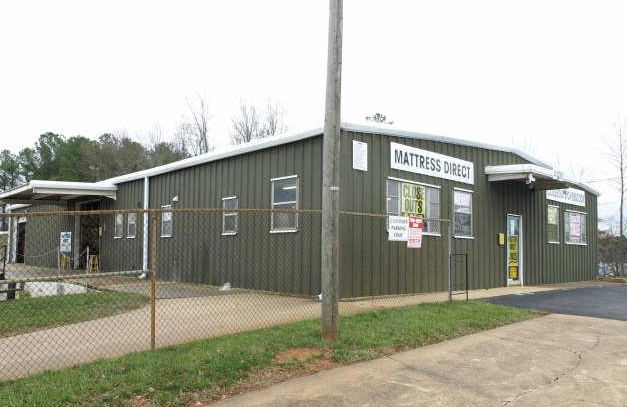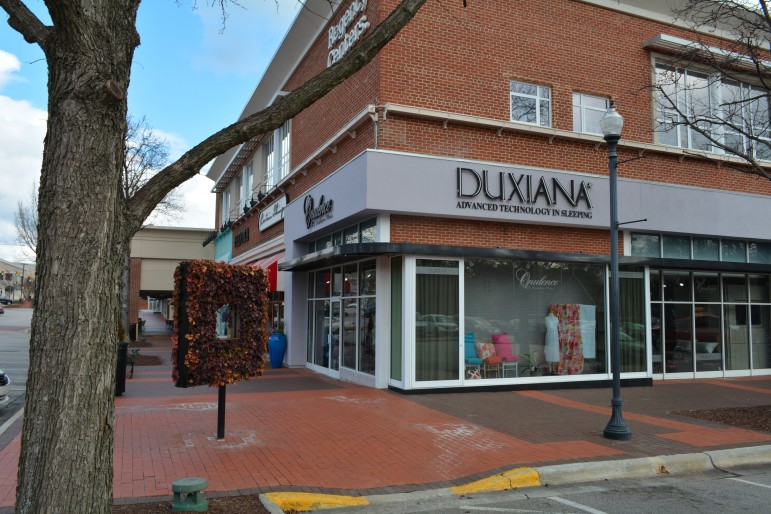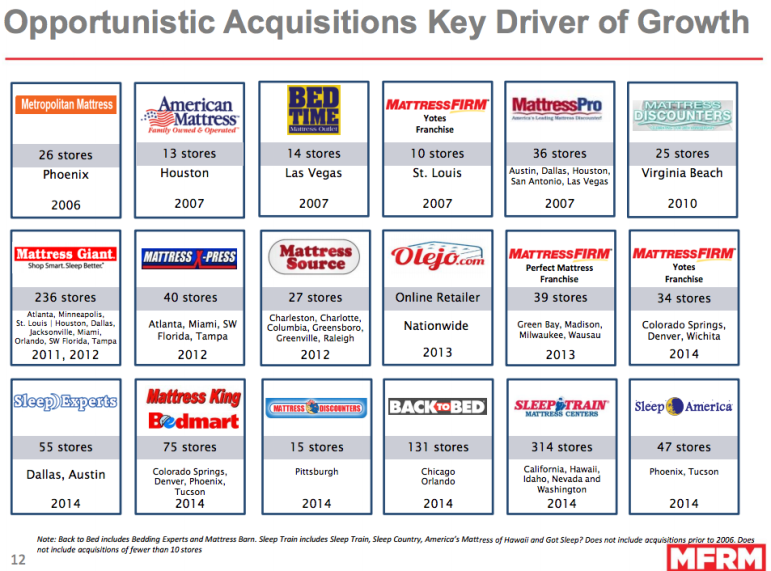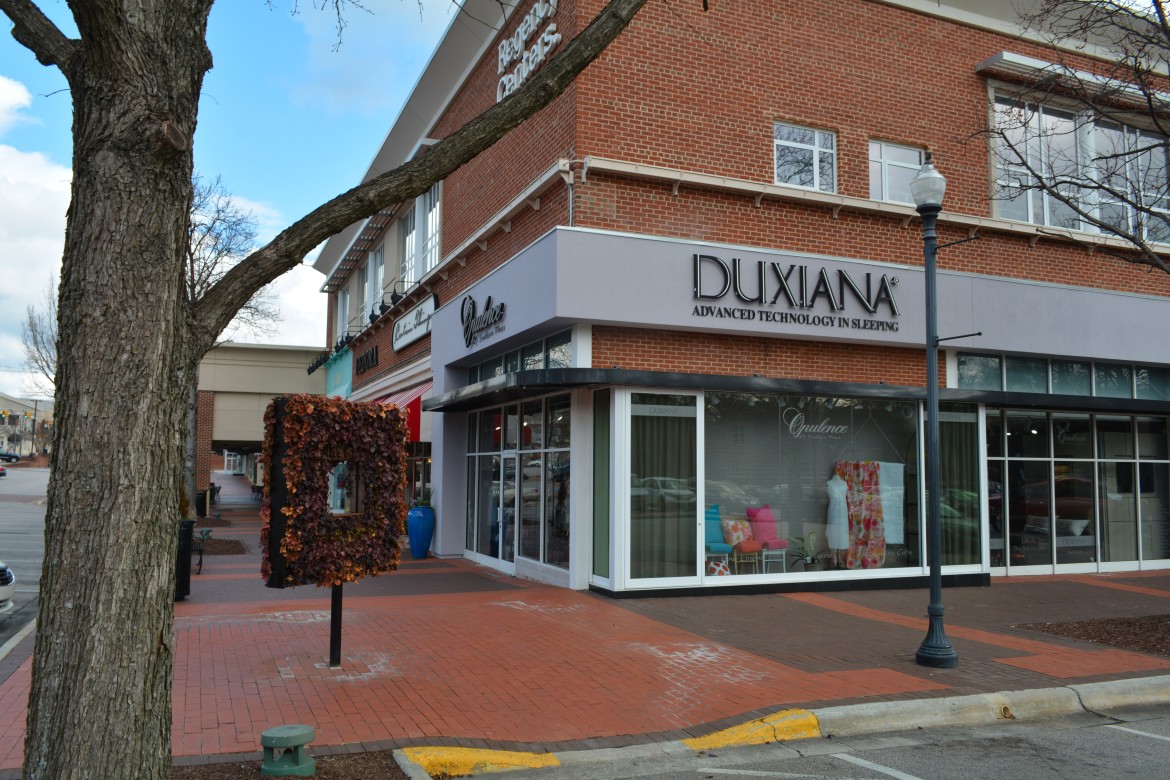Brought to you by Rufty-Peedin Design Build
Thursday, March 10, 2016
Here at the Development Beat, we like to seek out answers to the questions that really matter: How many parking spaces will a new office complex have? What kind of trees will a developer plant along the edges of their shopping center? Why do all the affordable apartment buildings keep getting torn down?
Today though, we’re going to tackle our biggest mystery yet: Exactly how many mattress stores are there in Raleigh anyway, and why are there so many of them?

Wake County
Mattress Direct, 4100 Atlantic Avenue. I set out to find the ugliest mattress store in Raleigh. I succeeded.
The answer to the first question turned out to be much easier to find than I’d imagined, thanks to this pretty impressive website Factual.com.
I’m not entirely sure what Factual’s primary purpose is, something to do with APIs and Application development, but they have a feature called “Global Places” where you can do a customized search for any type of store in any city in the country. It’s pretty amazing. And it seems to be pretty accurate, per a few spot-checks I ran.
According to Global Places, there are 44 different mattress stores in Raleigh. The Mattress Firm owns 18 of those locations, or almost half. I get that everyone needs a mattress, but it just strikes me as odd that there’s so many places to buy one. There’s about one mattress store for every 9,000 people living in Raleigh.
How often are people buying mattresses that this works? I wonder what the margin on a mattress store is. It has to be good, right? Otherwise, why keep building them? I just don’t get how it works.

James Borden / Raleigh Public Record
Duxiana at Cameron Village is probably Raleigh’s most upscale mattress store
Thankfully, Google proved to be my friend once again. I was able to find a PowerPoint presentation made to Mattress Firm investors that sheds some light on their success. Among the stunning insights: “Everyone sleeps,” and “Mattress sales are primarily replacement in nature with an ~10 year purchase cycle”
So…if there’s one store for every 9,000 people, and mattresses are being purchased in 10-year cycles, that works out to about 900 mattresses sold per store per year, right? A little less than three sold per day. I guess that works?
Let’s check the PowerPoint. Apparently it costs about $213,000 to open a new Mattress Firm store, and new stores are projected to make $950,000 in sales in the first year and $1 million in the second. The “four-wall profitability” which, to my understanding, is the net profit of a business after you factor in all the overhead costs, is $233,000 in the first year and $245,000 the second year.

That’s incredible. If only I had the agency to scrape together $230 grand, I’d definitely be investing it in a Mattress Firm.
The whole PowerPoint presentation is actually pretty interesting; I’m tempted to just keep pulling facts from it and posting them here, but if you’re interested, go check it out here. A few quick things worth noting: in 2015, Mattress Firm opened 201 new stores and acquired 668 competing stores. The company’s net sales were about $1.8 billion. In 2016, it opened between 200-220 new stores, listed no acquisitions and posted net sales of around $2.5 billion.
Of course, this information didn’t so much answer my question as confirm my obvious assumption that running a mattress store is profitable. Why are they so profitable? That’s what I really wanted to know. I found a few articles and blog posts offering up various hot takes on the subject, but the best overall analysis came from the magazine Psychology Today.
Most of its explanations echoed what I’d turned up elsewhere: a high profit margin, having a ton of locations serves as a sort of advertising campaign, most people still buy mattresses brick & mortar rather than online and there’s a pent-up demand for mattresses from the 2009 recession.

That all makes sense. But the author also made a final, somewhat off-topic point that I couldn’t agree with more: America doesn’t have too many mattress stores; it has too many stores.
She went on to write:
America has 46 square feet of retail space per capita. The equivalent per capita number in the UK is 9 square feet — less than one-fifth as much. And the U.K. has the most retail space of any country in Europe. So, seen with European eyes, America not only has too many mattress stores, it has too many stores period — from nail salons and donut shops to payday lenders and pharmacies. And, interestingly, it also has too many self-storage facilities…possibly for Americans to store away all those mattresses they are stocking up?
Ha!
As it happens, the genesis of today’s piece came from a conversation I had with Adam from Rufty-Peedin last week, where we were talking about the plethora of both storage facilities (Rufty-Peedin just recently received permits for one in North Raleigh, and Uncle Bob’s just received permits for a new facility at their South Raleigh location) and mattress stores getting built in Raleigh.
I decided it would be fun to run some numbers on Raleigh’s mattress stores & storage units and match them up against other cities. The results of that analysis are below.
For Raleigh only, I threw in some other types of retail for comparison and fun. You can interpret this data however you want. The biggest surprise to me was that there’s apparently more bookstores in Raleigh than mattress stores. Great news, but surprising nonetheless. And there are more Starbucks than Mattress Firms, but just barely!
Raleigh, population 431,746 has:
18 Mattress Firm branded stores. One for every 23,985 people.
44 mattress stores. One for every 9,812 people.
273 storage facilities. One for every 1,581 people.
186 drug stores. One for every 2,321 people.
136 pet stores. One for every 3,174 people.
389 bars (they don’t call it Drunktown for nothing…although to be fair, this number includes a lot of restaurants as well.) One bar for every 1,109 people.
15 video game shops. One for every 28,783 people.
65 bookstores. One for every 6,642 people.
25 Starbucks. One of these for every 17,269 people.
187 total coffee shops. One for every 2,308 people.
Charlotte, population 792,862 has:
54 mattress stores. One for every 14,682 people.
452 storage facilities. One for every 1,754 people.
Durham, population 245,745 has:
19 mattress stores. One for every 12,933 people.
127 storage facilities. One for every 1,935 people.
Chapel Hill, population 59,635 has:
2 mattress stores. Those UNC students never sleep! One for every 29,817 people.
24 storage facilities. One for 2,484 people.
The State of North Carolina, population 9.9 million, has:
577 mattress stores. One for every 17,577 people.
5,106 storage facilities. One for every 1,938 people.
Austin, TX, population 885,400 has:
78 mattress stores. One for every 11,351 people.
585 storage facilities. Wow. One for every 1,513 people.
Philadelphia, PA, population 1.5 million has:
51 mattress stores.One for every 29,411 people.
382 storage facilities. One for every 3,926 people.
So yes, in this very small but not quite-so-random sample, Raleigh has a higher ratio of mattress stores than any other city, and the second highest ratio of storage facilities, with Austin in a narrow first place. Who knows whether this would extrapolate nation-wide, but I’m pretty sure we could add “Highest Number of Mattresses Per Capita in the State” to Raleigh’s long and growing list of proud accomplishments.

Mattress Firm
Some of the competitors absorbed by Mattress Firm. RIP in Peace Mattress X-Press
